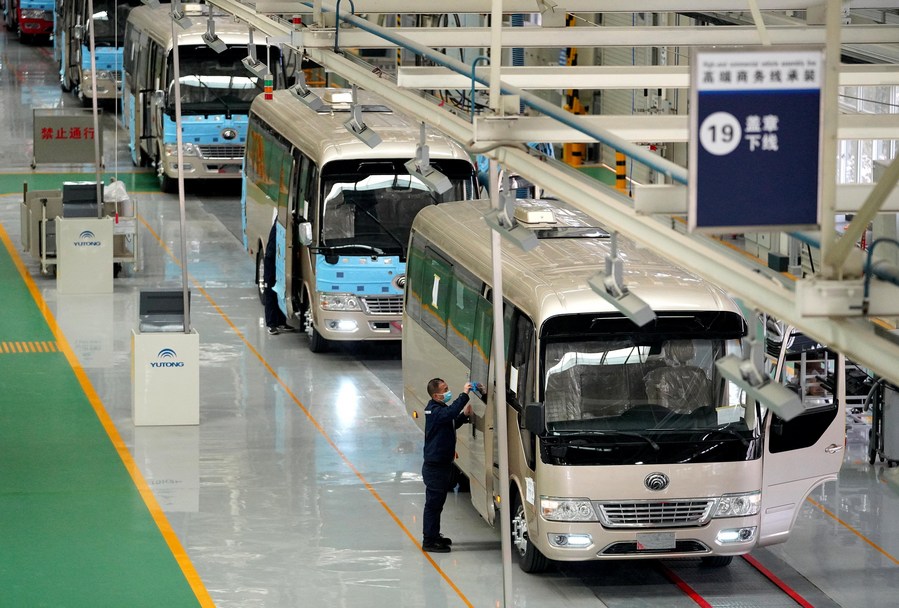Chinese local gov't fiscal revenue maintains steady growth
 0 Comment(s)
0 Comment(s) Print
Print E-mail Xinhua, June 07, 2023
E-mail Xinhua, June 07, 2023
* With a stream of supportive measures, Chinese local governments' fiscal revenue maintained steady growth, releasing positive signals for the nation's solid economic recovery.
* Despite the concerns over the mounting government debt risks, China is capable of and has ample room to navigate the economy through challenges.
BEIJING, June 6 (Xinhua) -- Chinese local governments' fiscal revenue maintained steady growth in the first four months of this year, backed by supportive measures, releasing positive signals for the nation's solid economic recovery.
Local governments' finances saw a revival this year. From January to April, Chinese local governments generated a total of 4.56 trillion yuan (about 641.71 billion U.S. dollars) in fiscal revenue, up 14.8 percent year on year, data from the Ministry of Finance (MOF) showed.
In the first quarter (Q1) of this year, most provincial-level governments registered positive growth in fiscal revenue, with Henan Province and Ningxia Hui Autonomous Region logging over 10 percent growth, according to data released by local governments.

Workers pack Chinese wolfberry products at a factory in Helan County of Yinchuan, northwest China's Ningxia Hui Autonomous Region, Jan. 31, 2023. (Xinhua/Wang Peng)
"The rapid economic improvement and the low base last year due to the pandemic paved the way for a recovery momentum of the growth of fiscal revenues this year," said Wang Zecai, a researcher with the Chinese Academy of Fiscal Sciences (CAFS).
Many provincial-level regions have seen fast growth in value-added tax (VAT) and corporate income tax, attesting to the quickened recovery of market vitality and the sound development of enterprises, said Feng Qiaobin with the Development Research Center of the State Council.
MEASURES IN PIPELINE
China's fiscal situation is expected to improve in 2023 with a rebound in the economy, according to research from the CAFS based on surveys with 521 city- and county-level finance departments, adding evidence to a brighter outlook of the nation's local finances.
However, given the facts that the impact of the pandemic is yet to dissipate completely and spending in key areas continues to rise, experts noted that the local governments' fiscal condition is likely to remain in a "tight balance."
"Excluding VAT and corporate income tax, revenues from other taxes grew slowly or even declined in Q1," Feng said, adding that the foundation for economic recovery is yet to be consolidated.

Tax personnel introduce tax preferential policies to a financial worker at battery manufacturer SCUD in Fuzhou, southeast China's Fujian Province, Feb. 7, 2023. (Xinhua/Wei Peiquan)
Fiscal departments at all levels are rolling out more measures to ease the financial strains.
The central government has pledged to provide more transfer payments to local authorities to help them deal with financial droughts caused by factors including massive tax and fee cuts. The size of these payments is expected to hit 10.06 trillion yuan this year, the highest level in recent years.
The country also decided to allocate another 500 billion yuan of transfer payments to local governments to support tax and fee cuts and basic livelihoods.
The central government also unveiled measures including asking central and local authorities to reduce general spending, establishing a regular mechanism to directly allocate budgetary funds to lower-level governments and intensifying local fiscal operations monitoring.
Some local authorities are also exploring ways to fill their coffers. The eastern province of Fujian, for instance, has expanded fiscal revenue by actively mobilizing state-owned resources. The income generated from the paid use of the state-owned resources topped 30.88 billion yuan in Q1, surging over 60 percent year on year.

An employee works on a high-end commercial vehicle assembly line at a new energy factory of Yutong Bus in Zhengzhou, central China's Henan Province, March 8, 2023. (Xinhua/Li An)
With the recovery of the economy and the real estate market, the sustainability of fiscal operations at local levels will improve, said Bai Yanfeng, a professor with the Central University of Finance and Economics.
CAPABLE OF DEFUSING RISKS
In response to the concerns over the mounting government debt risks, an MOF official pointed out that China's government debt ratio is not high in general.
The ratio of China's statutory debt to the country's GDP has been stable at around 50 percent, below the 60 percent international warning line and the level of major market economies and emerging markets.
China has been keeping its debt level controllable. By the end of 2022, the outstanding local government debt came in at about 35.07 trillion yuan, including 14.4 trillion yuan in general debt and 20.67 trillion yuan in special debt, all within the debt limit approved by the national legislature.
In recent years, tackling debt risks has been high on the policy agenda of the Chinese government. Finance authorities have tightened regulations on debt to hold firmly onto the bottom line of no systemic risk while promoting the establishment of a long-term mechanism to prevent and resolve hidden debt risks.
"Generally speaking, the fiscal condition in China is safe and healthy, leaving ample leeway for dealing with risks and challenges," the MOF official said.
The pressures and challenges of local finance can be successfully resolved through their own efforts and national policy support, Wang said, adding that a stable and sustainable financial situation will help the steady and long-term growth of the Chinese economy. ■
(Video reporters: Sun Qing, You Zhixin, Yang Shiyan; video editors: Zhang Li, Luo Hui, Liu Xiaorui)


